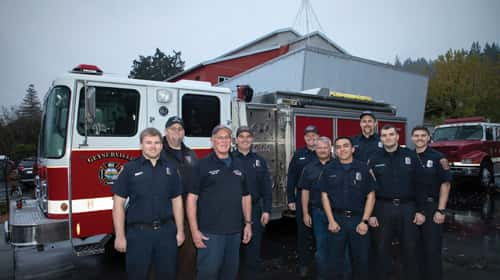Firefighters are our heroes. They face the menace of raging wildfires while others seek safety, and every day, they assist individuals experiencing traumatic events. Incredibly, many firefighters perform their duty without pay or the promise of pensions. The National Fire Protection Association reports that the United States contained more than 1 million firefighters in 2017, and 65 percent were volunteers, with small communities depending on them most. The majority of the volunteers—95 percent—were members of departments serving fewer than 25,000 people.
Fred Peterson, proprietor of Peterson Winery in the Dry Creek Valley, is one of them. As a volunteer at the Northern Sonoma County Fire Protection District since 1987 and a member of the district board, he’s committed to protecting the land he calls home and the people and property within. “When you can help someone in the community and make them feel better, that’s the payback. You’re responding to the worst day in someone’s life.” Volunteer firefighting is altruism at its best and underscores the selflessness of men and women throughout the North Bay. They step forward to help us through the worst of times, such as the wildfires of 2017 and more recently, the Kincade Fire.
Diverse Terrain
Early records show that the Geyserville Fire Department started in 1915 and became the Geyserville Fire Protection District in 1996. Recently, it’s evolved into the Northern Sonoma County Fire Protection District. Its territory covers more than 300 square miles, including Alexander Valley, Chalk Hill, Dry Creek Valley, Lake Sonoma, parts of unincorporated Healdsburg, and The Geysers, where the Kincade Fire sparked on Oct. 23, 2019, burning 77,758 acres before containment on Nov. 6. NSCFPD has a paid staff of six career firefighters and 22 volunteers, making it a combination department. Chief Marshall Turbeville works part-time and also has a regular job as a battalion chief with Cal Fire. Volunteers at NSCFPD carry pagers, and if they’re available, they drop everything to respond to emergencies.
 For both volunteers and paid staff, training standards are the same. “We encourage recruits to go through the volunteer firefighter academy,” says Peterson. It’s also suggested that volunteers become emergency medical responders or emergency medical technicians. Beyond training, he says the work requires self-confidence and a degree of sacrifice. “You get up in the middle of the night and go out, so you miss sleep,” he says. Though he no longer works on the front lines, he’s missed parts of Thanksgiving and Christmas with his family over the years. Volunteer firefighting is a substantial commitment of time and energy, according to Peterson, but he considers that part of the territory. “For a volunteer firefighter, it’s about helping others.”
For both volunteers and paid staff, training standards are the same. “We encourage recruits to go through the volunteer firefighter academy,” says Peterson. It’s also suggested that volunteers become emergency medical responders or emergency medical technicians. Beyond training, he says the work requires self-confidence and a degree of sacrifice. “You get up in the middle of the night and go out, so you miss sleep,” he says. Though he no longer works on the front lines, he’s missed parts of Thanksgiving and Christmas with his family over the years. Volunteer firefighting is a substantial commitment of time and energy, according to Peterson, but he considers that part of the territory. “For a volunteer firefighter, it’s about helping others.”
Peterson’s run as volunteer started when Geyserville still had an all-volunteer fire department. He grew up around fire stations—his father was a fireman—and he took a firefighting class while serving in the United States Navy. He also worked as a member of a U.S. Forest Service hand crew when he was a student at the University of California, Davis where he studied viticulture and enology. He describes winemaking and firefighting as very different occupations, but he enjoys both and finds that the opposing and complementary forces of yin and yang bring them together.
When he first joined the department, it responded to about 200 calls a year, whereas now it’s 600, making a strong volunteer contingent crucial to providing adequate emergency services. “You can’t afford enough paid staff in a small jurisdiction to deal with a large incident,” he says. Northern California has experienced devastating fires and floods in recent years, and he adds that a major earthquake is always a threat. In the case of fires, “Two things you can’t alter are the topography and winds. When we have the warm offshore winds, it’s like a large dam on top of a mountain and the dam breaks. It’s overwhelming. The beast takes over. There’s nothing you can do when it’s 9 percent humidity and winds are 45 miles per hour. It’s a very sobering experience.”
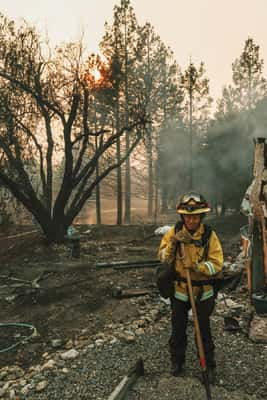 Two volunteers lost their homes in the Kincade Fire, so it’s become personal. “We want to do all we can to keep these fires from becoming the conflagrations we’ve seen. Preparedness needs to be part and parcel of people’s behavior. You’ve got to make it part of living with fire,” says Peterson. That means firefighters these days are also charged with educating people. They go out into their communities to get to know their neighbors and give them information and tips about how to protect themselves and their property. After the intense fires of 2017, not to mention the public safety power shutoffs performed by PG&E that coincided with the Kincade Fire, it’s a timely strategy.
Two volunteers lost their homes in the Kincade Fire, so it’s become personal. “We want to do all we can to keep these fires from becoming the conflagrations we’ve seen. Preparedness needs to be part and parcel of people’s behavior. You’ve got to make it part of living with fire,” says Peterson. That means firefighters these days are also charged with educating people. They go out into their communities to get to know their neighbors and give them information and tips about how to protect themselves and their property. After the intense fires of 2017, not to mention the public safety power shutoffs performed by PG&E that coincided with the Kincade Fire, it’s a timely strategy.
Valley and mountains
Created in 1980, the Mayacamas Volunteer Fire Department provides emergency services to a 7,200-acre area east of Sonoma Valley. Ranging in elevation from 300 to 2,500 feet, the land features weather extremes that can include low humidity and high winds in the warm months and snow-peaked mountains during winter. A rural area with 180 properties, the all-volunteer fire department consists of 12 members, two stations and four engines. “We do 100 percent of what any professional fire department does,” says MVFD board member Allison Ash. That means responding to calls for medical assistance and roadside blockages in addition to fires, day or night. “They go out in the pouring rain at 3 a.m., to move a downed tree,” she says. Like other departments, volunteers at MVFD have pagers rather than being on a shift and go to an emergency if they’re free. Most volunteers have regular jobs, according to Ash, so if they’re working, they can’t respond. Backup support is always available, however. “Like any volunteer fire department, we have mutual aid and automatic agreements with other fire agencies in our area.”
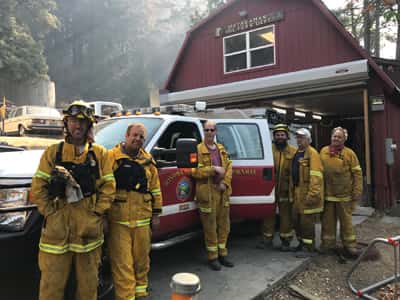 Those agreements and the spirit of cooperation they represent came into play the night of Oct. 8, 2017, when the Nuns Canyon Fire broke out in a field in Glen Ellen. “It was a crazy night,” says Ash, who was president of the board and received regular updates. “Everybody’s pager went off.” MVFD’s firefighters went into action to fight the blaze in Kenwood and Glen Ellen. “I remember hearing dispatch tell one of our firefighters, ‘Go to a burning house, and save the one next to it,” she says. The rapidly spreading fire soon reached their own community, and local firefighters worked alongside those from other areas, sharing crucial information about accessibility and where people lived. “In a rural area, that knowledge is indispensable,” Ash points out. Ultimately, 95 percent of MVFD’s service area burned, and five firefighters lost their homes.
Those agreements and the spirit of cooperation they represent came into play the night of Oct. 8, 2017, when the Nuns Canyon Fire broke out in a field in Glen Ellen. “It was a crazy night,” says Ash, who was president of the board and received regular updates. “Everybody’s pager went off.” MVFD’s firefighters went into action to fight the blaze in Kenwood and Glen Ellen. “I remember hearing dispatch tell one of our firefighters, ‘Go to a burning house, and save the one next to it,” she says. The rapidly spreading fire soon reached their own community, and local firefighters worked alongside those from other areas, sharing crucial information about accessibility and where people lived. “In a rural area, that knowledge is indispensable,” Ash points out. Ultimately, 95 percent of MVFD’s service area burned, and five firefighters lost their homes.
Pete Stewart has been on the MVFD board for seven years. During the Nuns Canyon Fire, his house was spared, but his land burned. Though he wasn’t yet a volunteer firefighter, he delivered items such as chain saws and oil to those battling the blaze and used buckets to take water out of pools and put out spot fires. “I jumped in unofficially and helped. It seemed like the right thing to do,” he says. At the time, Mayacamas had six volunteer firefighters and needed more. His daughters had left for college, giving him time to volunteer, and Stewart trained to become a firefighter. The Sonoma County Fire Academy operates at Santa Rosa Junior College, and he went to the first class it offered after the firestorm. He took nine weeks of classes, attending two times per week, and he participated in fire drills twice a month to learn relevant skills such as HazMat, swift-water rescues and hose-line techniques. Once Stewart graduated, he was ready to serve. “I was official,” he says. He earned several certificates in specific areas such as wildland fire and CPR, and when MVFD became part of Sonoma County’s Fire Volunteer Program, he started attending the county’s regular drills.
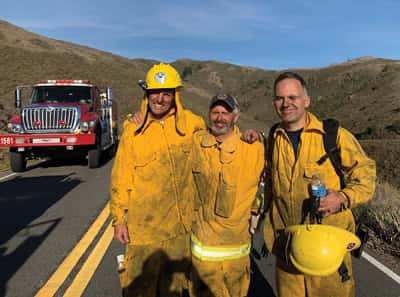 It requires juggling to be a volunteer while holding a regular job—Stewart is a salesperson for Young’s Market Company, specializing in wine and covering an area that ranges from Geyserville to Graton Casino and Sebastopol. “I start early in the morning, and I balance it,” he says, explaining that he might occasionally miss a fire department function, but drills are usually at night, and for the most part it works out. If there’s an emergency, he gets a call on his phone or sees a message on his pager, and he’ll respond if he’s nearby. The number of volunteers has grown, and thankfully, someone in the mountain community is usually available.
It requires juggling to be a volunteer while holding a regular job—Stewart is a salesperson for Young’s Market Company, specializing in wine and covering an area that ranges from Geyserville to Graton Casino and Sebastopol. “I start early in the morning, and I balance it,” he says, explaining that he might occasionally miss a fire department function, but drills are usually at night, and for the most part it works out. If there’s an emergency, he gets a call on his phone or sees a message on his pager, and he’ll respond if he’s nearby. The number of volunteers has grown, and thankfully, someone in the mountain community is usually available.
While large, dramatic fires get most of the attention because of the widespread danger they pose, the majority of calls are for other services. “I’ve been called to respond to a broken leg, many, many trees down and a car upside down,” Stewart says. He was once the first on the scene of a medical call and helped ease a victim’s pain. “I like the balance. I like all of it,” he says. What appeals to him most, though, is helping people and the camaraderie he shares with other firefighters.
Forest and coast
In a small coastal community in southern Marin County, the Muir Beach Volunteer Fire Department covers an area that stretches from the Pacific coast to the slopes of Mt. Tamalpais. John Sward (widely known as John John) started the fire department in 1972 and served as chief for many years, helping volunteer service become a near expectation for many residents. “We usually just approach them, or they approach us,” says Chief Chris Gove of potential recruits. He made the commitment after an assistant chief told him it was time to get involved.
The fire department consists of nine volunteers, including Gove, and most of them have served for 15 years or more. They come from a variety of backgrounds: Gove is a carpenter, while others include an art dealer with a studio in Sausalito, a landscape architect and a businessman who works in risk management for an insurance company. They too carry pagers, responding when they’re available. “During the weekend and night, we’re really populated,” says Gove. In the daytime, most have other demands, but do their best to help their department. Thus, when a fire broke out on the morning of Oct. 24, 2019, next to the Pacific Coast Highway between Muir Beach and Stinson Beach, five volunteers answered the call. They were part of a contingent of 150 firefighters and 13 fire agencies working together to beat back the blaze, called the Muir Incident, which burned 58 acres of dry grass and coast brush.
Most calls are medical, however, and many are for car accidents, falls, chest pains or breathing difficulty. Gove reports the fire department receives 70 to 100 calls a year, and more than half are to Muir Woods National Monument. A significant number are for accidents involving hikers and cyclists who are unfamiliar with the terrain and overestimate their abilities. All volunteers are EMRs at the minimum, while some are certified as EMTs. They must also fulfill Fire Fighter 1 requirements, a certification that became mandatory for volunteers as well as career firefighters in California after the terrorist attacks on the United States on Sept. 11, 2001. Training takes place three times a month, either at their firehouse or Marin County Fire Department’s Throckmorton Ridge Fire Station. “We take tests and demonstrate what we know,” says Gove, and firefighters keep logs of what they do and maintain their proficiency. “Our firehouse is empty all the time, except when we’re on call or doing training,” he says, but the fire department is a valued presence, nonetheless. “It’s a huge community builder,” he adds. “It’s probably more community-oriented than most.”
A sense of community
While emergency service is the priority, engines, equipment and training are expensive. Volunteers go beyond the line of duty to supplement a variety of taxes designated for fire protection by raising the funds necessary for their fire departments to operate effectively. In mid-November, for example, Peterson spent time preparing for the Geyserville Volunteer Firefighters Association’s pancake breakfast, which took place last year on Nov. 16, after being rescheduled from an October date that was canceled as a result of the Kincade Fire. “We have a very supportive community. Over the years, they’ve been very generous,” he says, adding that the proceeds of current fundraising are earmarked for preparedness and include the creation of digital topographic maps. “When people [firefighters from other areas] show up, you give them a thumb drive,” says Peterson, explaining that most fire engines have laptop computers. He adds, however, that as important as fundraising is, the sense of community that comes with such events is primary.
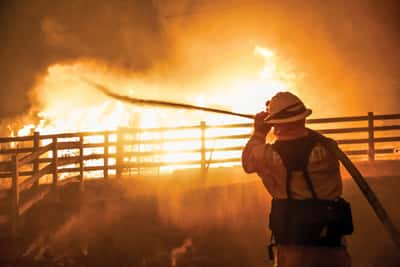 In Muir Beach, a barbecue on the Sunday of Memorial Day weekend is a highlight of the year that attracts 3,000 people and will celebrate its 48th year this May. It’s also the fire department’s main fundraising event. A firemen’s appreciation dinner in November is a newer event that always sells out. Kevin Corbit, board president of the Volunteer Firemen’s Association, and his wife, Kasey, who is also on the board, take the lead and do all the cooking, and half the town helps. As for the Mayacamas Volunteer Fire Department, it holds an annual Starlight Dinner and Auction. “We raise about half our funding there,” says Ash. She finds that people tend to give more after fires. “People were super generous and continue to be.”
In Muir Beach, a barbecue on the Sunday of Memorial Day weekend is a highlight of the year that attracts 3,000 people and will celebrate its 48th year this May. It’s also the fire department’s main fundraising event. A firemen’s appreciation dinner in November is a newer event that always sells out. Kevin Corbit, board president of the Volunteer Firemen’s Association, and his wife, Kasey, who is also on the board, take the lead and do all the cooking, and half the town helps. As for the Mayacamas Volunteer Fire Department, it holds an annual Starlight Dinner and Auction. “We raise about half our funding there,” says Ash. She finds that people tend to give more after fires. “People were super generous and continue to be.”
These events embody the spirit of the departments they support. Generosity and concern for others is at the heart of everything volunteer firefighters do, and their actions are unparalleled. “It‘s an honor to serve the community,” says Gove. “It’s a lot of hard work, and it’s worth every bit of it.” And we’re ever so grateful for their service.


